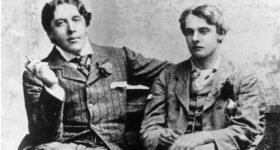
THE PLEASURE PARADOX
Philosophical Examination of Pleasure
Prior to contemporary accounts that examined the philosophy of pleasure, hedonism and epicureanism were widespread schools of thought that incorporated the ideas of pleasure into value theorems that denoted answers to the widely held question on how to live a fulfilling life. Hedonism is one such theoretical framework that entails a preliminary perspective on how humans should incorporate pleasure into their lives by presenting it as the highest good and most fundamental of all human actions. These propositions are consistent with scientific insights through psychology which suggest that our brains and neural wiring is powered in a way such that they are designed for pleasure and that the subsequent lack of pleasure is an immediate source of discomfort. Despite this, the idea of hedonism is often critiqued as it implies that if seeking pleasure is indeed the ultimate good, one may even consider pursuing immoral paths and actions in order to achieve it.
The moral limitations of plain hedonism gave rise to an amended form of thinking known as Ethical Hedonism which later grew into Hedonistic Utilitarianism which both emphasise the purist of pleasure done in the best interests of all societal players and that acts of pleasure that maximise total wellbeing are superior to those that minimise total wellbeing. These enhancements to hedonistic thinking can also be compared against another form of thinking known as Epicureanism which while being consistent to hedonistic pleasure posits that the absence of pain and state of tranquillity are also equivalent forms of pleasure which helped curtailed the perception of pleasure as the primary motive of all mortal beings. Through these advancements in thinking, pleasure was grounded in morality; the mere idea of immorally pursuing pleasure with a disregard for other beings was conceived to be wrong as it is today. Nonetheless excessive consumption of pleasure is still prevalent in cosmopolitan societies today and immoral pursuits may still arise when humanity is left in catastrophic predicament which once again brings light to hedonistic theories. But to what extent does the pursuit of pleasure help solve our lives’ quest for happiness? If pleasure if the ultimate good, why are many of those who are surrounded by the pleasures of life exhibit existential questioning? To do so we must seek the foundations of hedonistic theory and understand the metaphysical principles that govern pleasure which leads us to paradoxical proposition as philosophers have done before? The following theory develops this paradox by visualising it into matrices and simplistic words that are feasible to digest.
The Pleasure Properties-Human Experience Matrix
Before attempting to logically construct the pleasure paradox, it is helpful to relate the properties of pleasure to everyday human experiences. This involves understanding and examining hypothetical real-life examples in which the properties of pleasure are inherently displayed and identifying their relationship to the facets of human experience. In other words, we are trying to see the intersection between each property of pleasure to each dimension of human experience which can be ideally visualised through a 2D Matrix. However, in order to achieve this, we must further simplify the definition of human experience from its phenomenological complexity into three foundational dimensions: For the purpose of our analysis these dimensions are: Physical, Emotional, and Spiritual.
- Physical refers to sensory and bodily experiences, including activities like eating, exercising, and engaging in sexual activity. These experiences are directly tied to the tangible, corporeal aspect of being human.
- Emotional encompasses feelings and psychological states such as happiness, sadness, love, and anger. These experiences are integral to our mental well-being and shape our interpersonal relationships.
- Spiritual pertains to a sense of connection to something greater than oneself, which might include religious beliefs, philosophical reflections, and experiences of awe or transcendence. These experiences contribute to our sense of purpose and meaning in life.
Simplifying human experience into these dimensions not only enhances the model’s relevance but also makes it more comprehensible and easier to develop further through value theory. These dimensions would form the vertical axis of our matrix. Our final challenge is defining the properties of pleasure which is complex endeavour with various thinkers sharing diverse ideas. For the purposes of developing the pleasure paradox, I have coined three epithets, named the 3 Es, which effectively characterises pleasure leaning more towards its downside. Although summarised briefly below, we would explore these properties further in the following section where we would investigate the linear chronology between each propery and attempt to logically construct the paradoxical relationship between pleasure and human experience.
- Pleasure is Ephemeral: This refers to the fleeting, sensory, and bodily experiences, that area associated with pleasure-giving activities and behaviours which are often short-lived and directly tied to the tangible or corporeal aspect of being human. It relates to the idea of entropy, in which pleasure maybe viewed as an ecstatic energy that lasts a while before it immediately disorients and dissolves into the abyss of our minds.
- Pleasure is Eternal: This encompasses the idea that the need for pleasure and its pursuit remains a universal and invariant need that humans frequently crave and is crucial to our existence. As we see later, this describes the need rather than the impact of pleasure and demonstrates a link with Property 1.
- Pleasure is Evil: This concept typically pertains to the cynical view that due to the eternality of pleasure, it maybe consumed in ways that conflict with moral frameworks, leading to methods that pursue pleasure through extremely degenerate and detrimental ways that harm the wellbeing of others and themselves.
The matrix is born out of two axes with the properties of pleasure (3 Es) listed horizontally and the dimensions of human experience listed vertically. The intersection of a property and dimensions results in an example of an experience that connects properties with the dimensions of human experience. It is important to note that the matrix itself is not a concrete theorem and that there can be potentially limitless amounts of examples in each intersection that is formed.
| Physical | The satisfaction derived from eating a meal is short-lived; Hunger returns as it does three times a day during Breakfast, Lunch and Dinner. | The need for pleasure like food and sex are instinctually driven and remain an eternal and constant need by mortal beings. | The deprivation of food may lead to one attempting to steal or force its consumption from another person leading to harm. |
| Emotional | The ecstatic emotions presented during masturbation are desirable but short-lived leaving most people desiring for more. | Our inherent desire for social connections including both companionship and love remains an eternal need in our quest to meaning. | The inability to seek romantic attachment can lead to one grooming another into an affair resulting in a harmful and ingenuine relationship. |
| Spiritual | Spiritual Experiences like worship, sex and meditation are relinquished immediately after we are propelled back in to day-to-day struggles. | Our quest for meaning and spiritual fulfilment remains an integral part of our lives and within each human is a question on divinity that remains constant against time. | The pursuit of spiritual endeavours may cause indirect harm to others through compromise that maybe unfair to other parties. |
| Dimension / Property | Pleasure is Ephemeral | Pleasure is Eternal | Pleasure is Evil |
The Triangular Paradox of Pleasure – The 3Es
The paradox of pleasure is not some ground-breaking philosophical theory that is set to disorient the mannerisms of mankind but is a widely agreed consensus held along different philosophical thinkers that is to be expressed in an insightful manner. It is a paradox that stems from classical hedonistic theories that proclaim pleasure as the greatest virtue implying that the best way to live a fulfilling existence is to pursue acts of pleasure at every turn. This approach to life has issues inherent at its core which in turn can draw it ways to the trade-offs of pleasure that form an infamous insight – The Paradox of Pleasure. This paradox can be expressed graphically as a triangular pyramid with each vertex constituting a unique property of the human pursuit of pleasure that through interaction create the paradox that helps logically refute the claim that hedonistic living is the best way to live one’s life. To the linguistically-inclined these properties can be collectively referred to as the three.
The 3 Es start from the bottom left at the most fundamental property that characterises human pleasure:
- Pleasure is Ephemeral. This is a central tenet of the paradox of hedonism that posits that the pleasure derived from any pleasure-inducing activity like a sexual stimulation or culinary savouring is short-lived and temporary. The idea of attaining human flourishing through the repeated consumptions of pleasure is inconsistent with the idea that as a human species total fulfilment is never possible in the course of one’s ordinary existence. Upon consuming an act of pleasure, we are often left with a fleeting sense of completeness that lasts just under the fraction of a minute before it dematerialises, fades and delves deeper into the abyss of our minds where it is eventually extinguishes and restores us to our generalised state of human incompleteness. Hedonistic followers would resolve this loss by engaging in subsequent rounds of pleasure. However, if we pause to reflect, we can metaphorically view our lives as cycles oscillating between states of completeness and fulfilment. If we, as a human race, choose the pursuit of instant gratification as our approach to human flourishing, we will perpetually fluctuate between these two states in a constant flux whose net result would be an enduring sense of dissatisfaction, temporarily alleviated only by fleeting moments of pleasure. Moreover, if we analyse pleasure through its mathematical terms, subsequent pursuits of instant gratification yield diminishing marginal returns, suggesting that while overall pleasure may increase, it does so at a decreasing rate. The ephemeral principle thus implies that continuous gratification results in progressively smaller increments of pleasure which logically, according to hedonistic principles, can only be resolved by persisting acts of gratification, thus constructing the second property that
- Pleasure is Eternal: Although the idea that pleasure is eternal may initially sound oxymoronic when linked with ephemerality of pleasure, it must be understood that what this property entails is that the need for pleasure is eternal among humans given its ephemeral characteristics. Humans by nature would desire limitless amounts of money to cave into its many needs and wants similar to limitless amounts of sexual activity that allow us to experience ferocious orgasms that connect us as close as possible to the supremacy of eternal bliss. These basic insights are indicative that instant gratification is universal and invariant amongst members of the human race making it an eternal need to fuelling our existence. Most notably, the crucial factor that underscore this property is the previous roperty that entails the ephemerality of pleasure whereby by acts of gratification are insufficient in sustaining completeness creating a constant flux that propels us to consuming further rounds of pleasure making it an eternal need. This interrelationship forms the cornerstone to the triangular pleasure paradox and can be logically completed by the final property of pleasure which in turn is intertwined with the previous two properties.
- Pleasure is Evil: To complete our triangular paradoxical matrix, we must switch from deductive to abductive reasoning by assessing the likely implications that the previous two properties of pleasure entail on the greater good of humanity. One assessment concludes that if pleasure is ephemeral making it’s need eternal, hedonistic individuals may have the tendency to seek pleasure irrespective and devoid of the moral norms, constructs and principles that forms the constitution of modern day society. As such hedonists would be functioning on psychic drive that motivates them to immediately cave into impulses like the natural libidic or gastronomic drive with a disregard for the external environment. As such individuals have the capacity to be overpowered by self-interested psychic drives that can result in them engaging in morally corrupt or sadistic practices all in the name of gratifying pleasure. This principle is consistent with religions that encapsulate pleasure as a double-edged institution that if not restricted through ethical frameworks can morally corrupt humans by causing them to engage in evil which would ultimately be punished by what religion defined as predestination (Kismet),
Synthesis of Ideas
This thereby completes our triangular matrix and formulates our understanding on the paradox of pleasure. The diagrammatic representation helps plot the properties of pleasure which have been simplified through the 3 Es and thereby interconnected with arrows to show interactions that help revive this age-old paradox. In summary, instant gratification helps derive pleasure but is ephemeral (short-lived) to the extent that we are restored to our general state of incompleteness which we justify by engaging in subsequent acts of pleasure with diminishing marginal returns. As such our need for pleasure is eternal despite the outcome of pleasure being ephemeral creating a paradoxical bilateral relationship that through abductive reasoning could lead us to deploying evil strategies gratify our desires driven by an inner psychic tour de force. Henceforth, the paradox is logically completed and helps harness the terrifying portrait and shocking revelation of hedonistic lifestyles and their inherent meaningless.











Leave a Comment